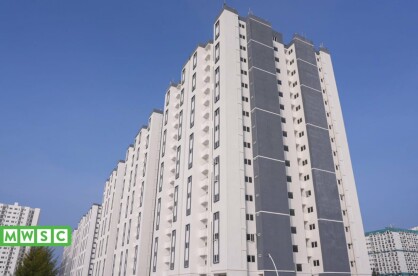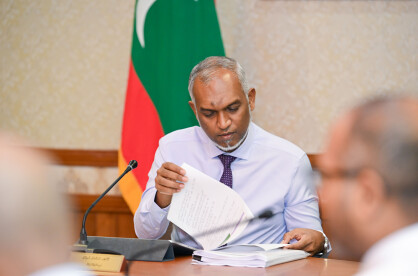Decentralising Public Finance
Effective decentralisation can only be achieved through fiscal decentralisation.

K. Dhiffushi Council - MFR Images
Effective decentralisation can only be achieved through fiscal decentralisation.

K. Dhiffushi Council - MFR Images
In March 2021, President Ibrahim Mohamed Solih, at the 'Decentralization Policy Coordination Conference,' stated that recent amendments made to the Decentralization Act would empower councils, providing the financial independence and support framework required for the development and prosperity of the islands. However, with the government preparing to submit its third budget to parliament by 31 October 2021, the question of whether fiscal decentralisation will be implemented to its fullest, and whether the government is really willing to relinquish its powers, especially its financial autonomy, needs to be raised and answered.
MFR sat down with former Minister of Finance and Treasury, Dr. Ahmed Inaz, to discuss his views on fiscal decentralisation.
Fiscal decentralisation is one of the key pledges of the current government and was sold as part of "Jazeera Dhiriulhun" or "Island Life," giving islands and atolls more power and authority over their own finances. The idea is to allocate a part of tax and other revenues to local government units so that they can better control their resources, and utilise it in the best interests of local communities and make economic decisions accordingly.

Clause 79 of the 8th amendment to the Decentralization Act states that all elected atoll, island, and city councils in the Maldives shall be allocated grants for state administration, provision of services and development projects through a formula determined by the Ministry of Finance. Under this clause, the total amount of block grants allocated from the budget should be at least 5 percent of total revenue and 40 percent of rental lease rent received to the central government budget from land, reefs and lagoons that are not under the jurisdiction of the councils.
This block grant is then apportioned with the majority allocated to the island councils (70 percent), while city councils are allocated 20 percent and atoll councils 10 percent. The apportionment of the grant to the individual councils is based on a fiscal formula, generated based on several factors, with the largest weight assigned to the resident population (60-75 percent,) followed by land area (5-15 percent) and distance from city and capital of the atoll (5-15 percent). In order to incentivise the councils, their performance is also used with a weight of 5 percent.
With these changes to the law and the government's pledges, funds allocated to councils has increased substantially over the past three years, compared to levels in 2018 – it increased two-fold from MVR570 million in 2018 to MVR1.3 billion in 2021. As per data published by the Ministry of Finance, councils have, as of 7 October 2021, spent over MVR1 billion (87 percent) of the budgets allocated to then, which is about 50 percent higher compared to 2020. However, a large proportion of this was on account of budget cuts due to COVID-19 in 2020.
However, on analysing the allocations over a longer horizon, it is shown that budget allocations had only increased marginally. Between 2013 and 2018, budget allocations to councils stood at an average of MVR800 million, while over the last three years it was MVR1 billion on average, showing a 30 percent increase. Moreover, as a percentage of total revenue, allocations to councils increased marginally, from an average of 5 percent between 2013 and 2018, to 6 percent between 2019 and 2021.
A large proportion of these funds allocated to councils are used for administrative expenses, and except for a few islands, most do not have any funds leftover to carry out development projects. Further, although the government has announced that implementation of Public Sector Investment Programs (PSIP) that are between MVR5 million and MVR15 million will be carried out by the councils, majority control and project formulation powers still rest with central ministries, such as the Ministry of National Planning, Housing and Infrastructure, which oversees over 400 projects valued at over MVR5 billion.
This has led to many proponents of further fiscal decentralisation raising their concerns and calling for alternative and more radical changes and alternative frameworks to ensure that decentralisation is carried out meaningfully.
Dr. Ahmed Inaz says that the government needs bring a regional focus back into play again by concentrating economic development in at least two to three main regions. One option may be to divide development focus into three regions, Region 1 (north), Region 2 (central) and Region 3 (south). Within the framework, he has highlighted the following key aspects to be focused.
Increase revenue allocations to councils
He recommends that budget allocations be increased to at least 50 to 60 percent of current revenues, such as from lease rents, GST (both general and tourism) and green tax, of the respective regions from which they are collected. From the current budget for 2021, this will correspond to approximately MVR9 to MVR11 billion, compared to the current allocation of MVR1 billion.
Use an equalisation formula to smooth out revenue disparities
Based on data published by the Maldives Inland Revenue Authority (MIRA), the central region, including Kaafu Atoll, collected the highest proportion of lease rents, at over MVR800 million or 49 percent the MVR 1.6 billion in lease rents collected in 2019, compared to MVR184 million, or 11 percent of the total in the south region. Given this huge disparity in distribution of revenue in the regions, which is based on the location of resorts across the country, Dr. Inaz suggests using an equalisation formula to smooth it out. He also suggests treating Greater Malé as a separate region.

Establish a loan fund for councils to tap into
Inaz suggests that after allocating 60 percent of revenue to local councils, the balance 40 percent could be allocated to the central government, with 60 percent of this allocated to recurrent and the balance 40 percent to capital and PSIP projects. Considering the numbers in the 2021 budget, this corresponds to MVR4 billion for central government recurrent expenditures, with MVR3 billion for the PSIP. Part of the PSIP allocations, say 50 percent, could be spent on national infrastructure projects and the balance as funds to provide loans or debt financing to councils to undertake larger PSIP projects in their own locality. These loans can be extended on a needs and performance basis, which can be used to encourage more efficient and faster implementation of PSIP projects – PSIP projects are currently plagued with slow implementation speeds and use up low levels of funds allocated each year.
Inaz agrees that this will require a fundamental shift in the budget allocation mechanism, as well as the thought processes behind these allocations. It will of course take time to dismantle and bring about the shift from a centralised administration to the more decentralised system envisaged. He also suggests establishing regional departments of MIRA, the Ministry of Finance and even the Maldives Monetary Authority, to ensure that funds are collected and re-distributed immediately.
Relocate jobs out of Malé
Further, given that many administrative jobs are currently located in Malé, these need to be re-allocated to the atolls and islands, through major shifts in government offices, schools and hospitals, devolving these to the councils, so that total administrative costs of the government are not hiked exponentially. That is, decentralisation should not mean adding an extra layer in addition to the current cadre of government employees, with an existing MVR8 billion wage bill, but relocating these positions out of Malé to where the actual work will be carried out.
With this changes, the offices and ministries in Male’ must focus on formulation of policies and standards to which regional and local councils must abide and as such these central governments need to have few caliber staffs. In addition, a regional monitoring system for polices and projects must also be set, so that central government can ensure its broad policies are implemented in line with its development priorities.
A key pre-requisite to implement this is to create pull factors in islands, such as providing allowances, and establishing hospitals, schools, universities and airport in the regions. Identifying two to three regional growth centres is essential in the sense that it will be impossible and costly to replicate this environment in each island. To have public buy-in though, the growth centres must be identified through a consultative political process.
However, the most important aspect for the success depends on the level of power sharing the central government is willing to relinquish. In previous administrations also regional development centres were formed but failed to materialize the benefit since at central level all aspects were controlled and the regional offices were like additional extensions of main offices without any responsibility and accountability. Hence, with this change, a ministry such as Ministry of National Planning, Housing and Infrastructure, must not be involved in the implementation of projects like development of a harbour in an island, but the full project from the development phase to implementation need to decentralize to the councils with the allocation of required budget to the councils
Build capacity at council/regional levels
One of the key challenges in rolling out such a system will be the budget and cash flow management capabilities in the islands. Transparency Maldives (TM) has recommended that the government provide regular and comprehensive training and other capacity building opportunities for council staff, and to earmark a certain percentage of the budgets of the council for such efforts.
TM also highlighted the importance of inclusivity in the national development planning process, so that all councils are driven not only be regional targets but national Sustainable Development Goals (SDGs). A comprehensive mechanism to monitor regional level SDGs and performance indicators is also important to identify where government interventions may be required.
The above is of course not a comprehensive framework that encompasses all the aspects of a very complex and intricate effort that needs to be implemented to reap the full benefits of decentralisation. It is not enough to just allocate a certain proportion of revenues to councils and expect them to develop their islands and atolls. A more comprehensive, all-in and well thought out framework needs to be established, incorporating all aspects of the issue, to ensure that fiscal, administration and developmental decentralisation bears fruit.



